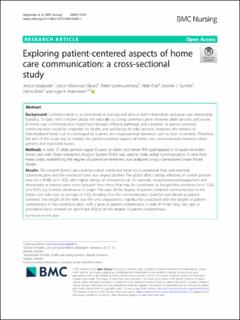| dc.contributor.author | Höglander, Jessica | |
| dc.contributor.author | Eklund, Jakob Håkansson | |
| dc.contributor.author | Spreeuwenberg, Peter | |
| dc.contributor.author | Eide, Hilde | |
| dc.contributor.author | Sundler, Annelie J. | |
| dc.contributor.author | Roter, Debra | |
| dc.contributor.author | Holmström, Inger K. | |
| dc.date.accessioned | 2020-10-14T10:12:28Z | |
| dc.date.available | 2020-10-14T10:12:28Z | |
| dc.date.created | 2020-10-03T08:34:14Z | |
| dc.date.issued | 2020 | |
| dc.identifier.citation | Höglander, J., Eklund, J. H., Spreeuwenberg, P., Eide, H., Sundler, A. J., Roter, D., & Holmström, I. K. (2020). Exploring patient-centered aspects of home care communication: a cross-sectional study. BMC nursing, 19(91), 1-10. | en_US |
| dc.identifier.issn | 1472-6955 | |
| dc.identifier.uri | https://hdl.handle.net/11250/2682719 | |
| dc.description.abstract | Background: Communication is a cornerstone in nursing and aims at both information exchange and relationship building. To date, little is known about the naturally occurring communication between older persons and nurses in home care. Communication might heal through different pathways and a patient- or person-centered communication could be important for health and well-being of older persons. However, the delivery of individualized home care is challenged by routines and organizational demands such as time constraints. Therefore, the aim of this study was to explore the patient-centered aspects of home care communication between older persons and registered nurses.
Methods: In total 37 older persons (aged 65 years or older) and eleven RNs participated in 50 audio-recorded home care visits. Roter Interaction Analysis System (RIAS) was used to code verbal communication. A ratio from these codes, establishing the degree of patient-centeredness, was analyzed using a Generalized Linear Mixed Model.
Results: The present home care communication contained more socio-emotional than task-oriented communication and the emotional tone was largely positive. The global affect ratings reflected an overall positive tone (m = 39.88, sd = 7.65), with higher ratings on dimensions of, for example, responsiveness/engagement and interactivity or interest were more frequent than those that may be considered as less-positive emotions (m = 15.56, sd = 3.91), e.g. hurried, dominance or anger. The ratio of the degree of patient-centered communication in the home care visits was an average of 1.53, revealing that the communication could be considered as patientcentered. The length of the visits was the only characteristic significantly associated with the degree of patientcenteredness in the communication, with a peak in patient-centeredness in visits 8–9 min long. Sex, age or procedural focus showed no significant effects on the degree of patient-centeredness.
Conclusion: Overall, the degree of patient-centeredness and a positive emotional tone, which might have a positive outcome on older persons’ health, was high. Longer visits provided a higher degree of patientcenteredness, but no linear increase in patient-centeredness due to length of visit could be observed. The findings can be used for education and training of nurses, and for providing individualized care, e.g. patient- or personcentered care. | en_US |
| dc.language.iso | eng | en_US |
| dc.rights | Navngivelse 4.0 Internasjonal | * |
| dc.rights.uri | http://creativecommons.org/licenses/by/4.0/deed.no | * |
| dc.title | Exploring patient-centered aspects of home care communication: a cross-sectional study | en_US |
| dc.type | Peer reviewed | en_US |
| dc.type | Journal article | en_US |
| dc.description.version | publishedVersion | en_US |
| dc.rights.holder | © The Author(s), 2020. | en_US |
| dc.source.volume | 19 | en_US |
| dc.source.journal | BMC Nursing | en_US |
| dc.source.issue | 91 | en_US |
| dc.identifier.doi | https://doi.org/10.1186/s12912-020-00483-1 | |
| dc.identifier.cristin | 1836718 | |
| cristin.ispublished | true | |
| cristin.fulltext | original | |
| cristin.qualitycode | 1 | |

